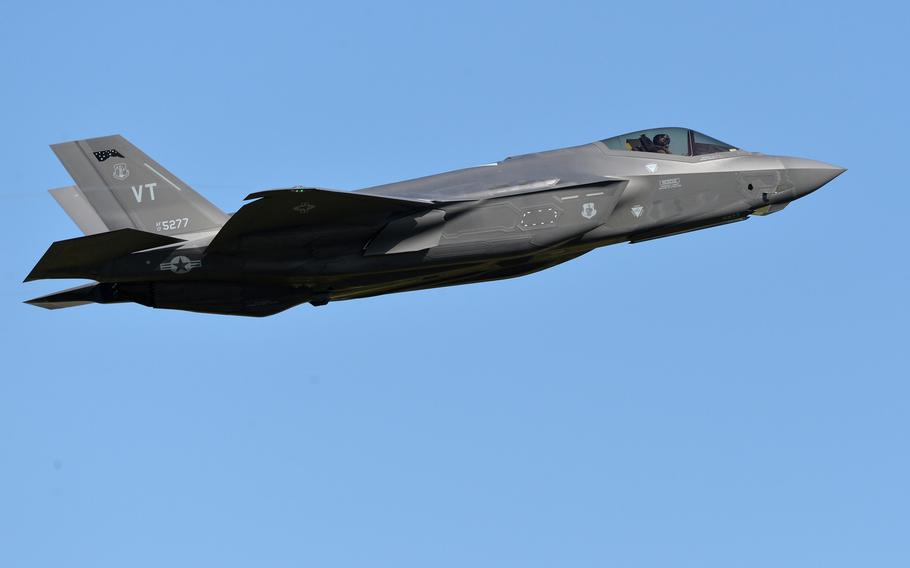
An F-35 Lightning II of the Vermont Air National Guard’s 158th Fighter Wing takes off from Spangdahlem Air Base, Germany, in 2023. While Congress appears to have funded NGAD, the U.S. Air Force may be considering cuts or delays in the program in favor of updating the military’s current F-35s. However, updating F-35s would do little to ameliorate issues like the F-35 fleet’s full mission capable rate standing at a lackluster 30%. Meanwhile, refusing to commit to NGAD would provide years of leeway for adversaries to continue developing their air superiority capabilities. (Michael Abrams/Stars and Stripes)
U.S. adversaries are threatening to set the world on fire, and Washington and its allies need to restore deterrence before it is too late. In anticipation of a war in the Pacific, China is hoarding fuel, food, raw materials and other strategic inputs, restoring strategic stockpiles to levels unprecedented since Mao Zedong. Russia’s war against Ukraine shows the Kremlin’s willingness to threaten Europe, while Moscow’s rhetoric levied against NATO stokes fears of wider, potentially nuclear conflict. Future wars may involve NATO allies, as well as U.S. naval and air power in the Pacific, and are likely to be even higher intensity than the slog in Ukraine.
In the Red Sea, Iranian-backed Houthis have disrupted international shipping, challenging the U.S. Navy and driving costs of international commerce and global inflation up. Hezbollah, another Iranian proxy, is launching missiles which murdered children in Northern Israel on July 28.
China is building up air and naval power to threaten Taiwan, the Philippines, and other neighbors in Southeast Asia. The West has been slow to respond, with U.S. domestic debt service and social allocations constraining the military budget. European countries still depend on the U.S. to provide military power, as their forces are understaffed, their weapons systems over-redundant, and procurement — discombobulated.
In the Russia-Ukraine War, FAB-3000 3.4 ton precision-guided bombs, and drones and missiles launched from the distance against civilian energy infrastructure with the intent to make the country unlivable in this coming winter represent a key part of Russian strategy. Rebuilding the infrastructure destroyed by these strikes is costly and futile since restored power stations can be hit again. To defend against these attacks, any targeted country would require anti-air missiles. Even more so, it would require air superiority platforms to shoot down Russian planes launching the bombs and missiles.
Should Russia, or China, be inclined to recycle these tactics in future conflicts, the costs will stretch Western resources thin. The United States needs to boost its own technological capabilities by funding next-generation programs like the Next Generation Air Dominance (NGAD) platform to restore deterrence and prevent similar attacks. The U.S. and its allies also need to develop and deploy a host of cheap, mass-produced drones and anti-drone systems and countermeasures.
Specifically, to offset our adversaries’ swift advances in air superiority, including the Chinese sixth generation air dominance program, the U.S. needs to adopt the most up-to-date capabilities to combat such threats. The Chinese sixth generation platform is anticipated to have similar capabilities to NGAD, including a “loyal wingman” function, wherein an individual aircraft will be assisted by unmanned craft to perform a variety of functions tailored toward each mission. This function is especially critical to compete with “kamikaze” drone warfare that forces manned aircraft to engage with explosive unmanned craft.
To ensure air combat dominance and superior electronic warfare, and to enhance its long-range ground-attack power, the U.S. Air Force needs the NGAD platform, which represents the sixth generation of American fighter jets and surrounding ecosystem. By adopting the NGAD program, the United States can remain dominant against its adversaries.
Though proceeding with such a program may be a sound decision, it is far from guaranteed. While Congress appears to have funded NGAD, the U.S. Air Force may be considering cuts or delays in the program in favor of updating the military’s current F-35s. However, updating F-35s would do little to ameliorate issues like the F-35 fleet’s full mission capable rate standing at a lackluster 30%. Meanwhile, refusing to commit to NGAD would provide years of leeway for adversaries to continue developing their air superiority capabilities.
The U.S. and its allies have been slowly losing their deterrence in the international system. This dynamic is already showing its ill effects across the global security landscape and the world’s economy. It is inviting aggression against the U.S. and against allies in Europe, the Middle East, and eventually, in Asia. Aggressors have developed capabilities to utilize airpower featuring gliding bombs in Ukraine, high-impact, low-cost drones in the Red Sea, and missiles in the Levant. Yet, these will be a sideshow in comparison with enemy six generation fighters if the U.S. lacks one.
If the United States forgoes the development of NGAD, adversaries will develop devastating sixth generation fighters with accompanying drone systems, denying the U.S. air superiority for the first time since World War II. America needs to restore deterrence and to develop the cutting-edge technologies that help it win wars and keep peace for over a century.
Wes Martin, a retired U.S. Army colonel, has served in law enforcement positions around the world and holds a MBA in International Politics and Business.